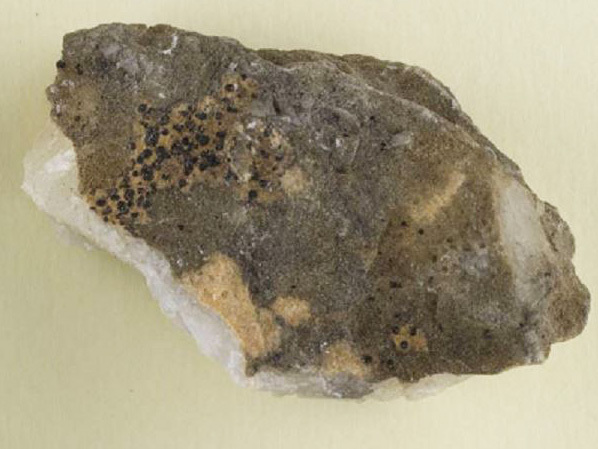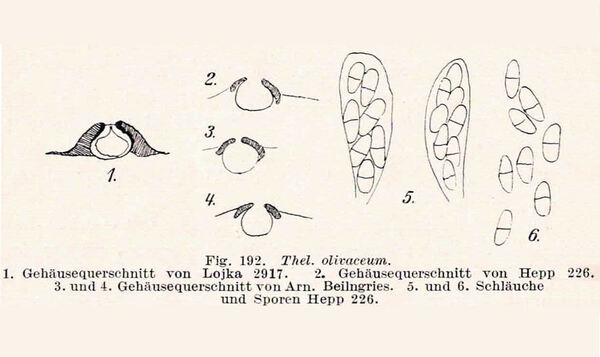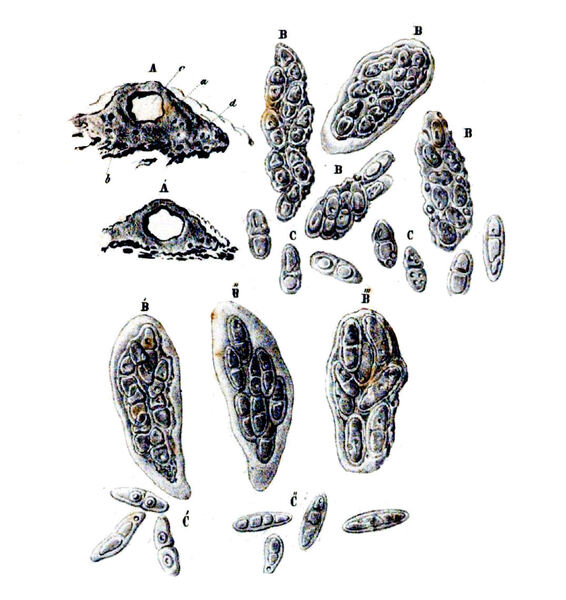Thelidium olivaceum auct.
. Basionym: Verrucaria olivacea Fr. - Lich. Eur. Reform.: 438, 1831, nom. illegit.
Synonyms: Arthopyrenia pseudolivacea (Nyl.) H. Olivier; Involucrothele pseudolivacea (Nyl.) Servít; Verrucaria olivacea Fr. nom. illegit.; Verrucaria pseudolivacea Nyl.
Distribution: N - Ven, TAA, Lomb, Emil (Fariselli & al. 2020), Lig (Giordani & al. 2025). C - Tosc (TO 2924), Abr. S - Cal (Puntillo 1996).
Description: Thallus crustose, thinly episubstratic, often fleck-like, greenish brown or medium brown, continuous or more or less rimose. Thallus not paraplectenchymatous; medulla often forming a black basal layer. Perithecia black, 0.1-0.2 mm across, 1/4-1/2-immersed, projecting with the upper part, often covered at base by a thalline layer. Involucrellum extending to the base of exciple, appressed or slightly diverging at base; exciple dark in upper part, pale below; hamathecium of periphyses and periphysoids, interascal filaments absent; hymenial gel I+ red (I+ blue at very low concentrations of I), K/I+ blue. Asci 8-spored, narrowly ellipsoid to clavate, I-, fissitunicate, the wall thickened above, ocular chamber usually present; dehiscence by extrusion of a delicate endotunica as a long rostrum. Ascospores 1(-3)-septate, hyaline, ellipsoid, 14-25(-34) x 6-12(-14) µm. Photobiont chlorococcoid. Spot tests: K-, C-, KC-, P-, UV-. Chemistry: without lichen substances.Note: a circumboreal-montane species of calcareous rocks, most common in the Alps. There is a nomenclatural problem with this species: Thelidium olivaceum (Fr.) Körb. is based on Verrucaria olivacea Fr. (1831), nom. illeg., non Pers. (1794).
Growth form: Crustose
Substrata: rocks
Photobiont: green algae other than Trentepohlia
Reproductive strategy: mainly sexual
Commonnes-rarity: (info)
Alpine belt: rather rare
Subalpine belt: rather common
Oromediterranean belt: extremely rare
Montane belt: very rare
Submediterranean belt: absent
Padanian area: absent
Humid submediterranean belt: absent
Humid mediterranean belt: absent
Dry mediterranean belt: absent

Predictive model
Herbarium samples
Growth form: Crustose
Substrata: rocks
Photobiont: green algae other than Trentepohlia
Reproductive strategy: mainly sexual
Commonnes-rarity: (info)
Alpine belt: rather rare
Subalpine belt: rather common
Oromediterranean belt: extremely rare
Montane belt: very rare
Submediterranean belt: absent
Padanian area: absent
Humid submediterranean belt: absent
Humid mediterranean belt: absent
Dry mediterranean belt: absent

Predictive model
| Herbarium samples |
 DOLICHENS
DOLICHENS





